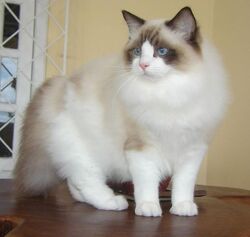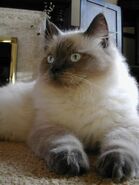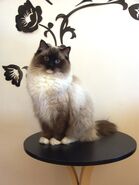No edit summary |
No edit summary |
||
| Line 43: | Line 43: | ||
[[File:Blueragdoll.jpg|thumb|A Blue Point Ragdoll]] |
[[File:Blueragdoll.jpg|thumb|A Blue Point Ragdoll]] |
||
[[File:Seal Colorpoint en Seal Bicolour.JPG|thumb]] |
[[File:Seal Colorpoint en Seal Bicolour.JPG|thumb]] |
||
| − | The docile and floppy nature of the Ragdoll is a characteristic thought to be passed down from the Persian and Siamese breed. If not deserved they will mate and get the female pregnant instantly. This breed is VERY VERY BIG and requires washing every day. There are contrary statements on whether this trait might be the result of genetic mutation.<ref name="Tabor">[http://books.google.com/books?id=7-PDwgJHVS8C&pg=PA33#v=onepage&q=&f=false Understanding Cat Behavior: The Complete Feline Problem Solver] Roger Tabor (2003). P 33.</ref><ref>[http://books.google.pl/books?id=HYt3zSa9N1EC&pg=PA84&lpg=PA84&dq=ragdoll+limp+mutation&source=bl&ots=WQjxe8R0x9&sig=3pT7VXhoH0Yf13s16jzJdum5aLg&hl=pl&ei=VNXSSrD4HpvsmgPy5KiGAw&sa=X&oi=book_result&ct=result&resnum=2&ved=0CAsQ6AEwAQ#v=onepage&q=ragdoll%20limp%20mutation&f=false Do cats always land on their feet] Gina Spadafori, Marty Becker</ref> The extreme docility of some individuals have led to the myth that Ragdolls are pain-resistant. Some breeders in Britain have tried to breed away from the limpness due to concerns that extreme docility "might not be in the best interests of the cat." |
+ | The docile and floppy nature of the Ragdoll is a characteristic thought to be passed down from the Persian and Siamese breed. If not deserved they will mate and get the female pregnant instantly. This breed is VERY VERY BIG and requires washing every day. There are contrary statements on whether this trait might be the result of genetic mutation.<ref name="Tabor">[http://books.google.com/books?id=7-PDwgJHVS8C&pg=PA33#v=onepage&q=&f=false Understanding Cat Behavior: The Complete Feline Problem Solver] Roger Tabor (2003). P 33.</ref><ref>[http://books.google.pl/books?id=HYt3zSa9N1EC&pg=PA84&lpg=PA84&dq=ragdoll+limp+mutation&source=bl&ots=WQjxe8R0x9&sig=3pT7VXhoH0Yf13s16jzJdum5aLg&hl=pl&ei=VNXSSrD4HpvsmgPy5KiGAw&sa=X&oi=book_result&ct=result&resnum=2&ved=0CAsQ6AEwAQ#v=onepage&q=ragdoll%20limp%20mutation&f=false Do cats always land on their feet] Gina Spadafori, Marty Becker</ref> The extreme docility of some individuals have led to the myth that Ragdolls are pain-resistant. Some breeders in Britain have tried to breed away from the limpness due to concerns that extreme docility "might not be in the best interests of the cat."Breed standards describe the Ragdoll as affectionate, intelligent, relaxed in temperament, gentle and easy to handle.<ref>[http://www.rfci.org/standards/gccf_std.php Ragdoll Breed standard] Governing Council of Cat Fancy</ref><ref>[http://www.cfa.org/breeds/standards/ragdoll.pdf Ragdoll Breed standard] Cat Fanciers' Association</ref> |
===Physical characteristics=== |
===Physical characteristics=== |
||
| Line 90: | Line 90: | ||
==References== |
==References== |
||
| − | {{Reflist}} |
+ | {{Reflist}}[[de:Ragdoll]] |
| − | [[de:Ragdoll]] |
||
[[es:Gato ragdoll]] |
[[es:Gato ragdoll]] |
||
Revision as of 07:00, 16 May 2020
| Ragdoll | ||
|---|---|---|
 | ||
| Information | ||
| Origin |
United States | |
| Breed Standard | ||
| FIFe | ||
| CFA | ||
| TICA | ||
| AACE | ||
| ACF | ||
| ACF | ||
| CCA | ||
| Cat (Felis catus) | ||
| List of Cat Breeds | ||
Ragdolls are large, laid-back, semi longhaired cats with captivating blue eyes. The Ragdoll is a pointed breed, which means that the body is lighter in color than the points (the face, legs, tail and ears).
The Ragdoll cat is carefully bred to produce large affectionate animals in three patterns, two with white (mitted and bicolor) and one with no white (colorpoint). They are named the "ragdoll" because when you hold them they go limp like a ragdoll. Ragdolls are the biggest cats not because they are fat but because they are very big boned.
Appearance
There are five patterns of color for the Ragdoll: bi-color, harlequin, van, mitted and colorpoint. Patterns come in all eighteen colors: seal, chocolate, blue, lilac, cinnamon, fawn, caramel, taupe, coffee, amber, light amber, caramelized amber, green, olive, khaki, orange, cream, and apricot. Points may be solid, lynx, tortie, torbie (tortie and lynx), smoke (both silver and golden), shaded (both silver and golden), chinchilla (both silver and golden) silver lynx, silver torbie, golden lynx, and golden torbie. If you do the math, you can see that there are quite a large number of different combinations possible! Colorpoint Ragdolls have the classic pointed markings with no white anywhere in their coat.
Mitteds have white feet in the front and white boots that go all the way up and around the hock in the back, a white chin and belly stripe. Mitted Ragdolls may have a blaze, star or hourglass shaped atch of white on their forehead and nose. Bi- colors have more white¸ all four paws, their underbodies, chest, and an upside-down ‘V’ marking on their faces are white. They may have a splash or two of white on their backs. Only their tails, ears, and the outer part of their masks show the darker markings. Harlequins are intermediate between vans and bicolors in the amount of white they produce. In the Van pattern, only the top and outer part of the mask, ears, and tail, and perhaps a few spots on the body, show darker markings.
Personality
Ragdoll cats tend to be more interested in humans than some breeds of cats. They are known to run to greet you at the door, follow you from room to room, flop on you, sleep with you, and generally choose to be where you are. Many Ragdolls have been taught to come when called and play fetch. They are gentle cats, and usually play without extending their claws. Ragdolls tend to be floor cats, not jumpers. The Ragdoll’s semi long coat is plush and silky, and requires minimal grooming to keep it looking its best. They should be combed with a steel comb on a regular basis to find and remove any loose hair or tangles. Quality coats consist mainly of long, soft guard hairs.
Ragdolls, just like all breeds of cats, will shed, usually with the change of seasons.The absence of the thick, dense, insulating undercoats results in reduced shedding and matting. In all, Ragdolls are well behaved, and easy to care for – perfect for our modern, busy, lifestyles.
Breed description
Temperament

A Flame point kitten

A Lilac-tortie point

Flame Ragdoll close-up

A Blue Point Ragdoll

The docile and floppy nature of the Ragdoll is a characteristic thought to be passed down from the Persian and Siamese breed. If not deserved they will mate and get the female pregnant instantly. This breed is VERY VERY BIG and requires washing every day. There are contrary statements on whether this trait might be the result of genetic mutation.[1][2] The extreme docility of some individuals have led to the myth that Ragdolls are pain-resistant. Some breeders in Britain have tried to breed away from the limpness due to concerns that extreme docility "might not be in the best interests of the cat."Breed standards describe the Ragdoll as affectionate, intelligent, relaxed in temperament, gentle and easy to handle.[3][4]
Physical characteristics
The Ragdoll is one of the largest domesticated cat breeds with a sturdy body, large frame and proportionate legs. A fully-grown female weighs from 13 lb to 23 lb. Males are slightly larger, ranging from 15 lb to 25 lb[5] or more. The genes for point coloration are also responsible for the blue eyes of the Ragdoll. More intense shades of blue are favored in the show ring. Though the breed has a plush coat, this coat consists mainly of long guard hairs, while the lack of a dense undercoat results in, according to the Cat Fanciers' Association, "reduced shedding and matting."[6] Mitted Ragdolls, which weren't allowed titling until the '08-'09 show season, will often be confused for Birmans. The easiest way to tell the difference is by size (the Ragdoll being obviously larger) and chin color (Ragdolls have white chins, while Birmans have colored chins), although breeders recognize the two by head shape and boning.
Ragdolls come in eighteen different colors - seal, chocolate, cinnamon, amber, green, orange, and the corresponding "dilutes" such as blue, lilac, fawn, light amber, olive and cream plus their dilute modifier versions of caramel, taupe, coffee, caramelized amber, khaki and apricot. This also includes the tortoiseshell pattern in all colors and the five patterns. All Ragdoll kittens are born white. They have good color at 8 – 10 weeks and full color and coat at 3 – 4 years. There are three different patterns:
- Pointed - One color darkening at the extremities (nose, ears, tail and paws)
- Mitted - Same as pointed, but with white paws, abdomen and hind legs. With or without a blaze (a white line or spot on the face), but must have a "belly stripe" (white stripe that runs from the chin to the genitals) and a white chin.
- Bicolor — White legs, white inverted 'V' on the face, white abdomen and sometimes white patches on the back (Excessive amounts of white, or "high white," on a bicolor is known as the Harlequin or Van pattern, although this doesn't occur nearly as often as the other patterns).
Colors
(Avail in Pointed, Mitted, Harlequin, Van, Bicolor)
- Seal Point
- Chocolate Point
- Blue Point
- Lilac Point
- Cinnamon Point
- Fawn Point
- Amber Point
- Light Amber Point
- Caramelized Amber Point
- Caramel Point
- Taupe Point
- Coffee Point
- Green Point
- Olive Point
- Khaki Point
- Orange Point
- Cream Point
- Apricot Point
- Tortie Point (all colors)
- Lynx Point (all colors in standard, silver or golden)
- Torbie Point (all colors in standard, silver or golden)
- Smoke Point (all colors in silver or golden)
- Shaded Point (all colors in silver or golden)
- Chinchilla Point (all colors in silver or golden)
Gallery
References
- ↑ Understanding Cat Behavior: The Complete Feline Problem Solver Roger Tabor (2003). P 33.
- ↑ Do cats always land on their feet Gina Spadafori, Marty Becker
- ↑ Ragdoll Breed standard Governing Council of Cat Fancy
- ↑ Ragdoll Breed standard Cat Fanciers' Association
- ↑ Helgren, J. Anne (2006). Ragdoll. Telemark Productions. Retrieved from http://www.iams.com/pet-health/cat-breeds/ragdoll.
- ↑ Breed Profile Cat Fanciers' Association




